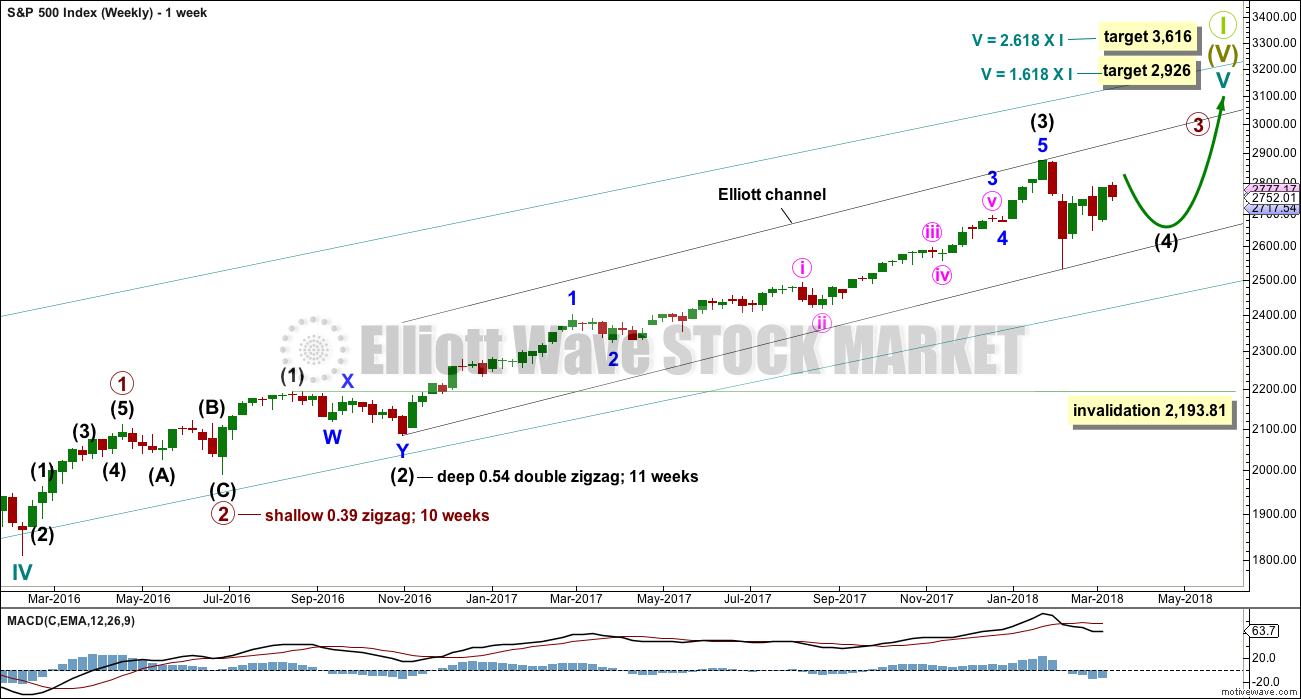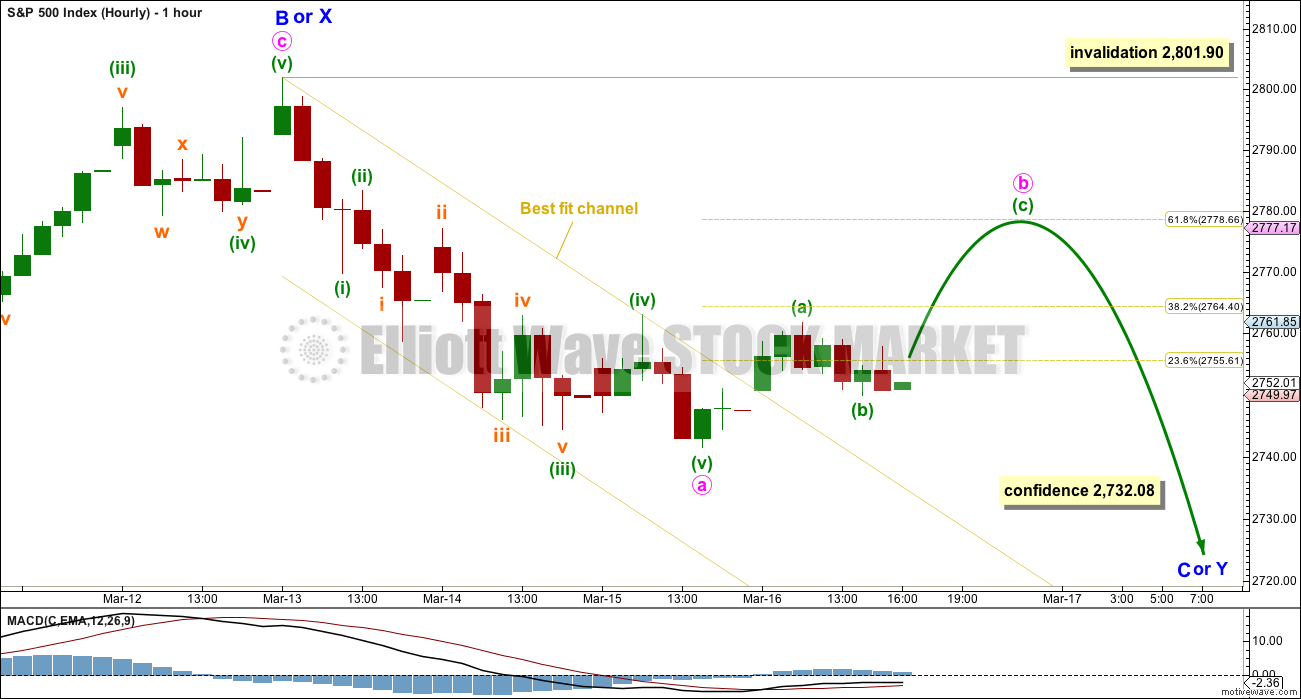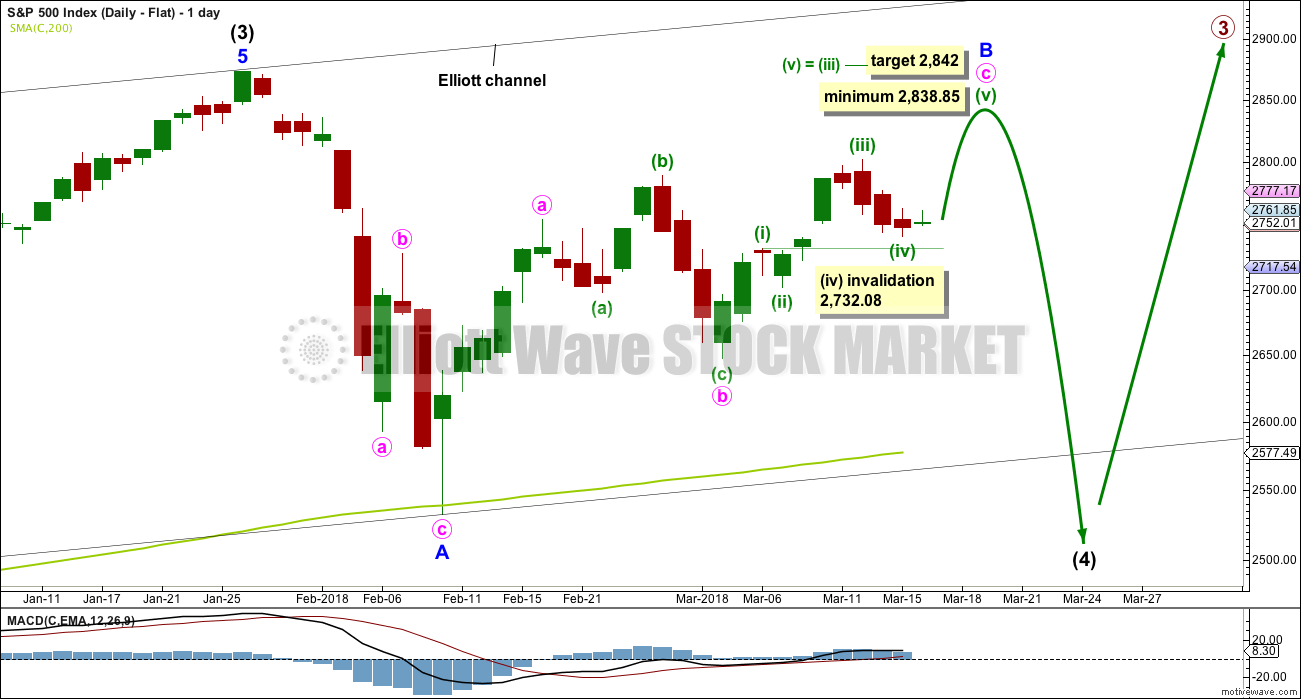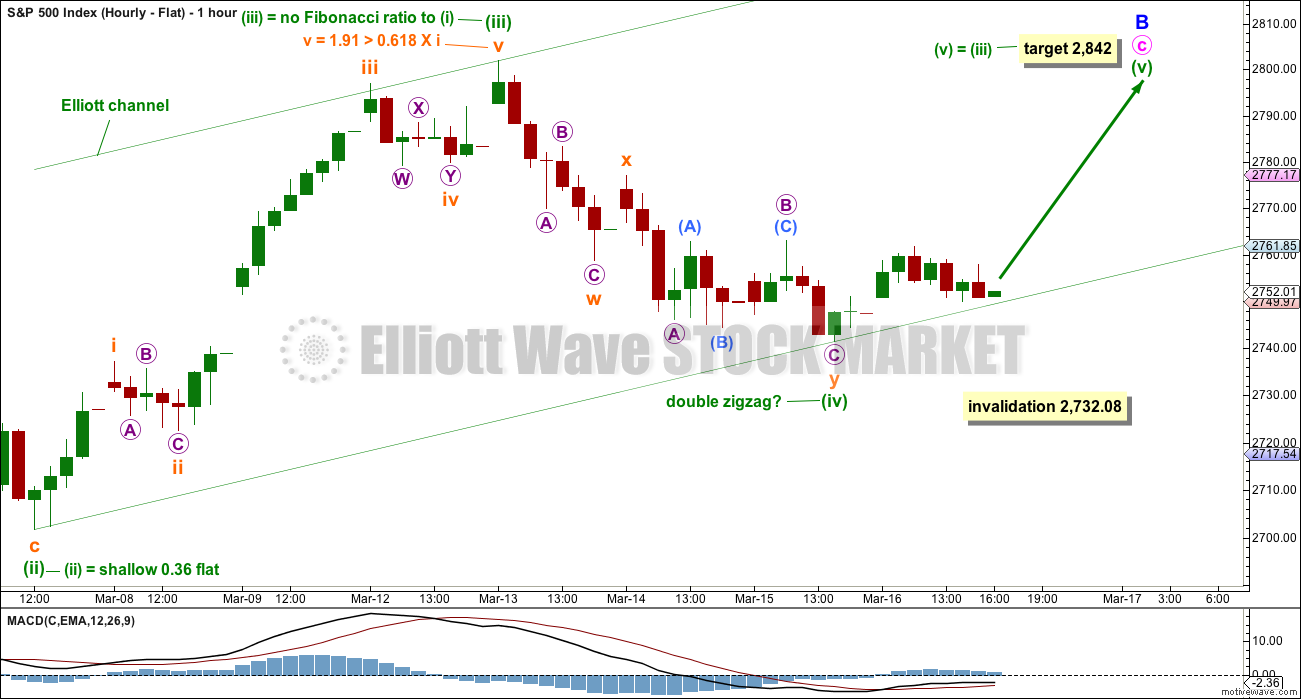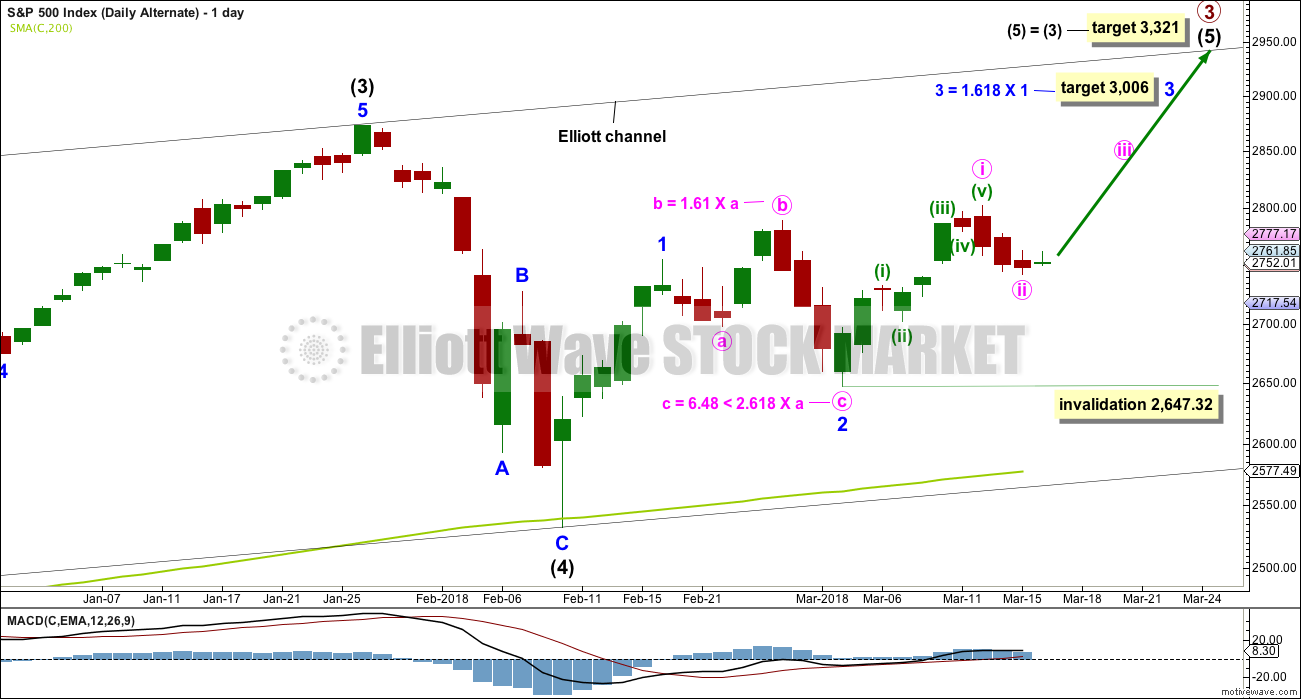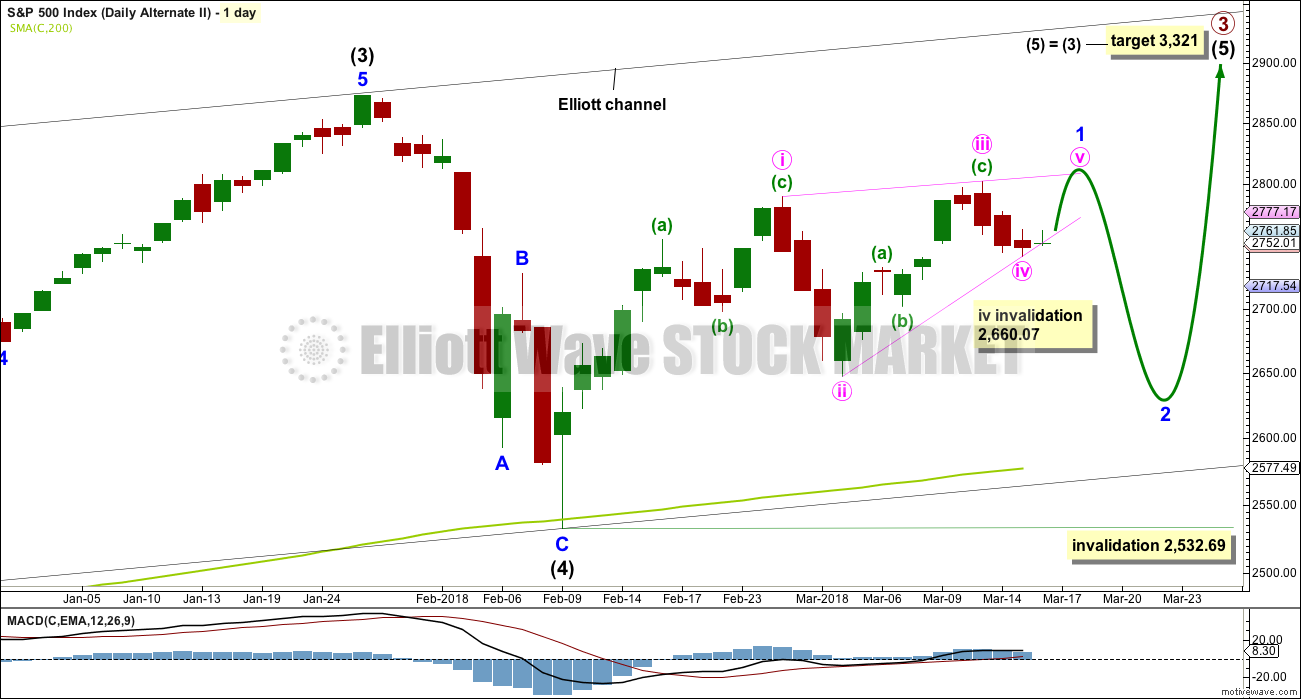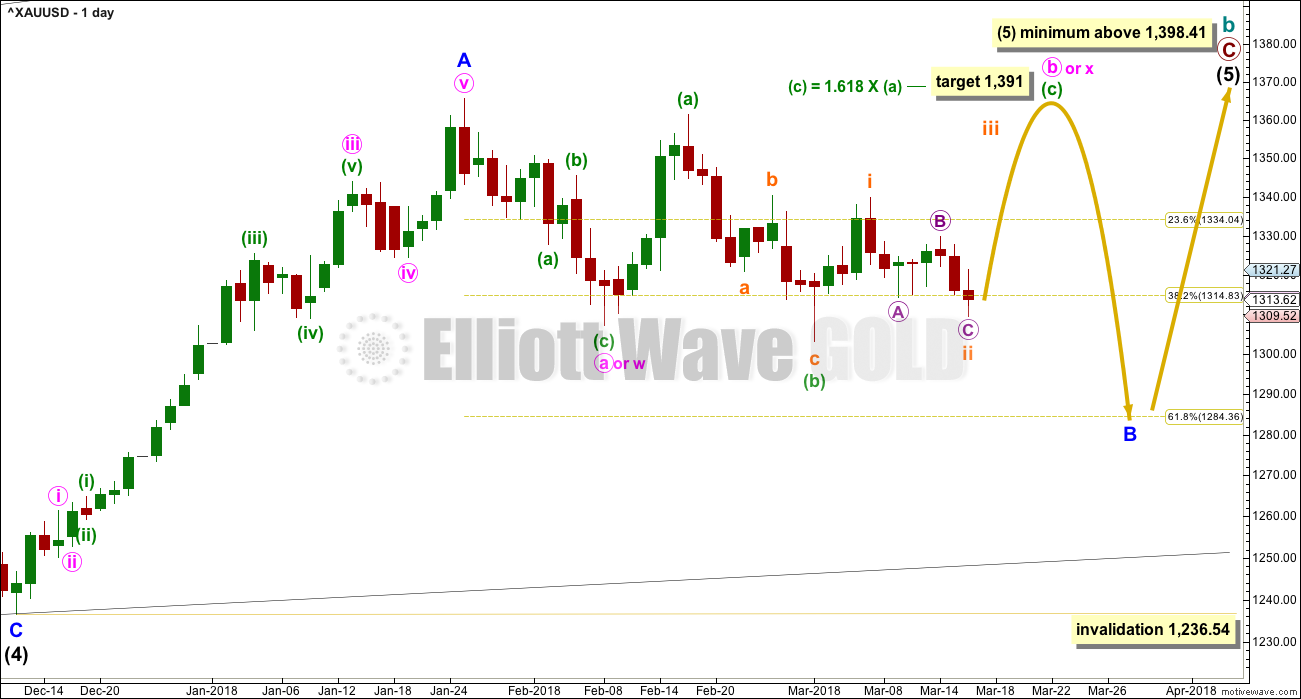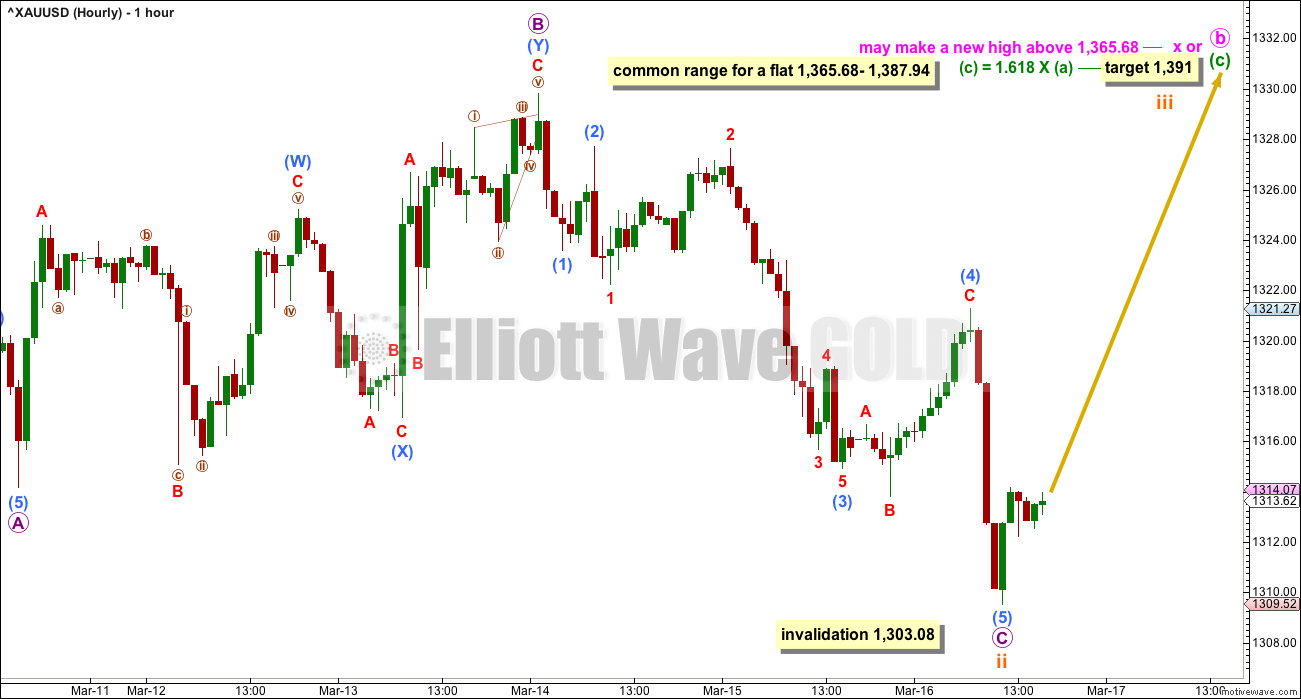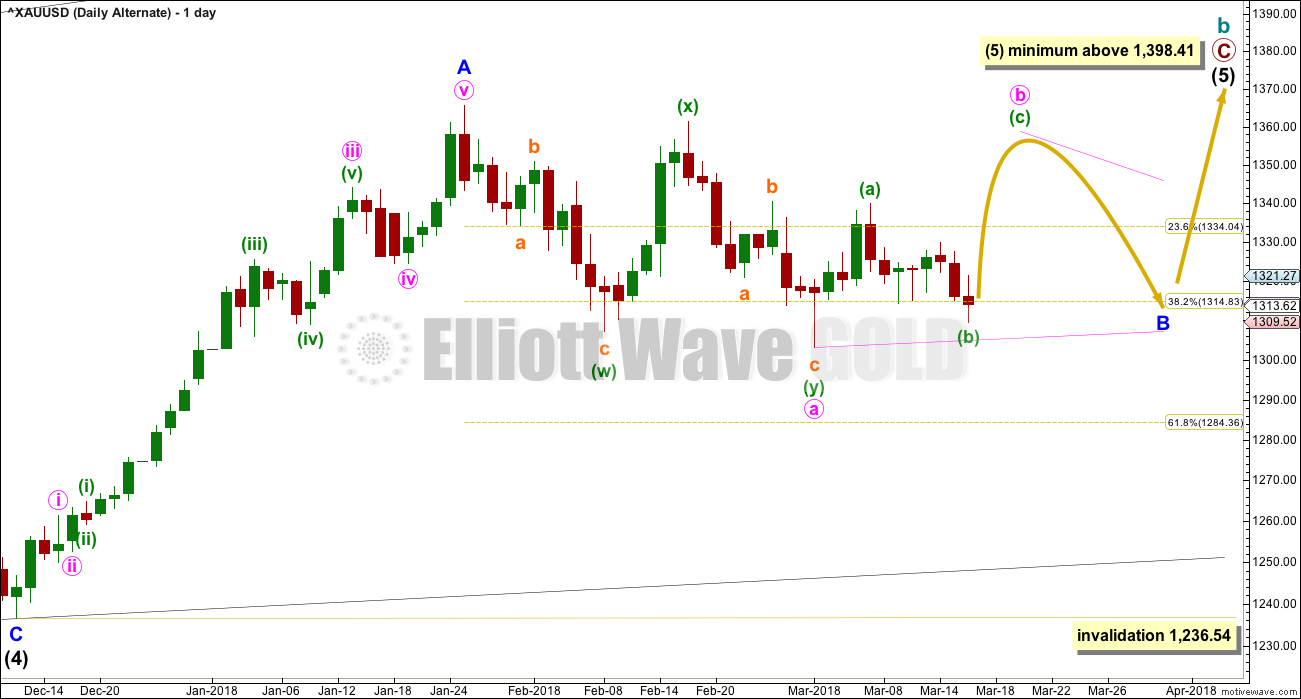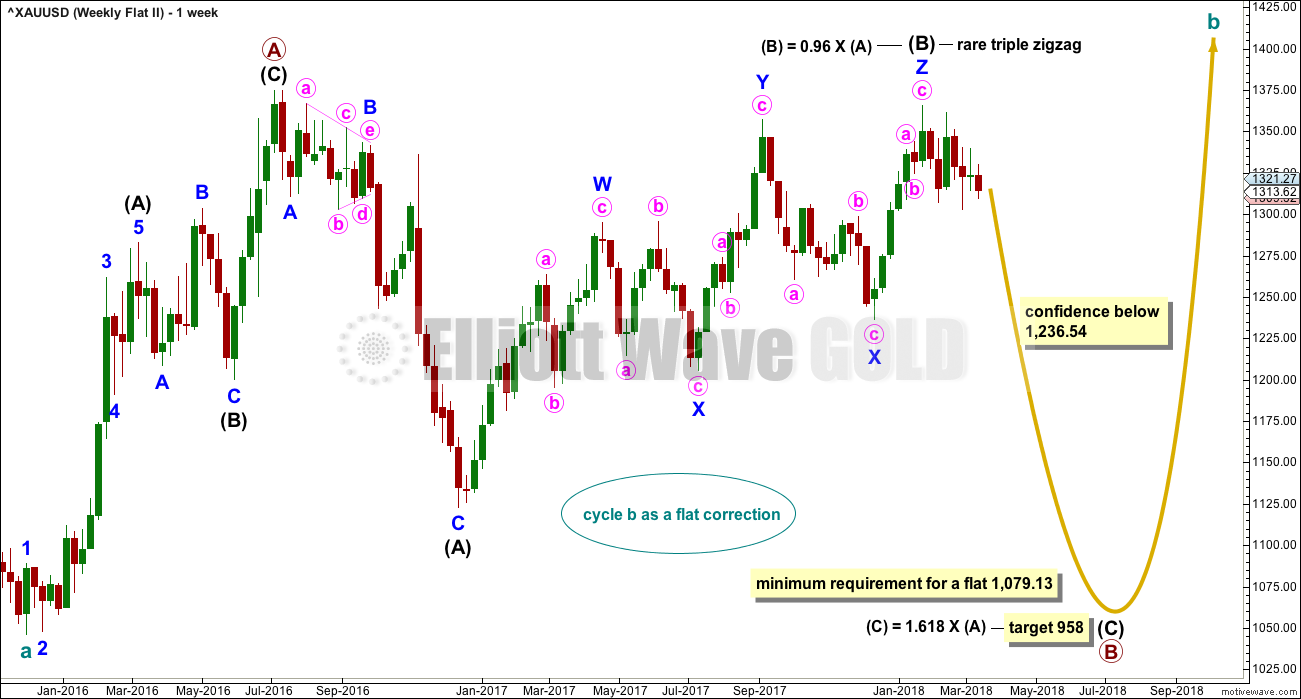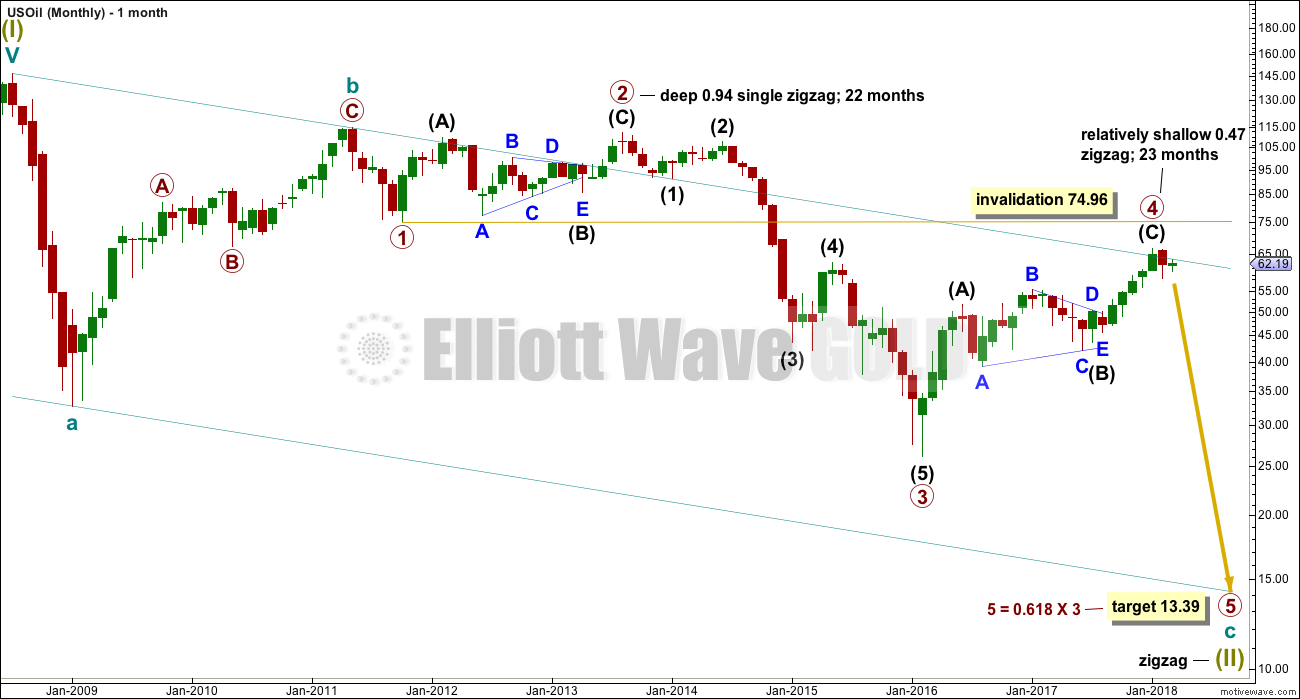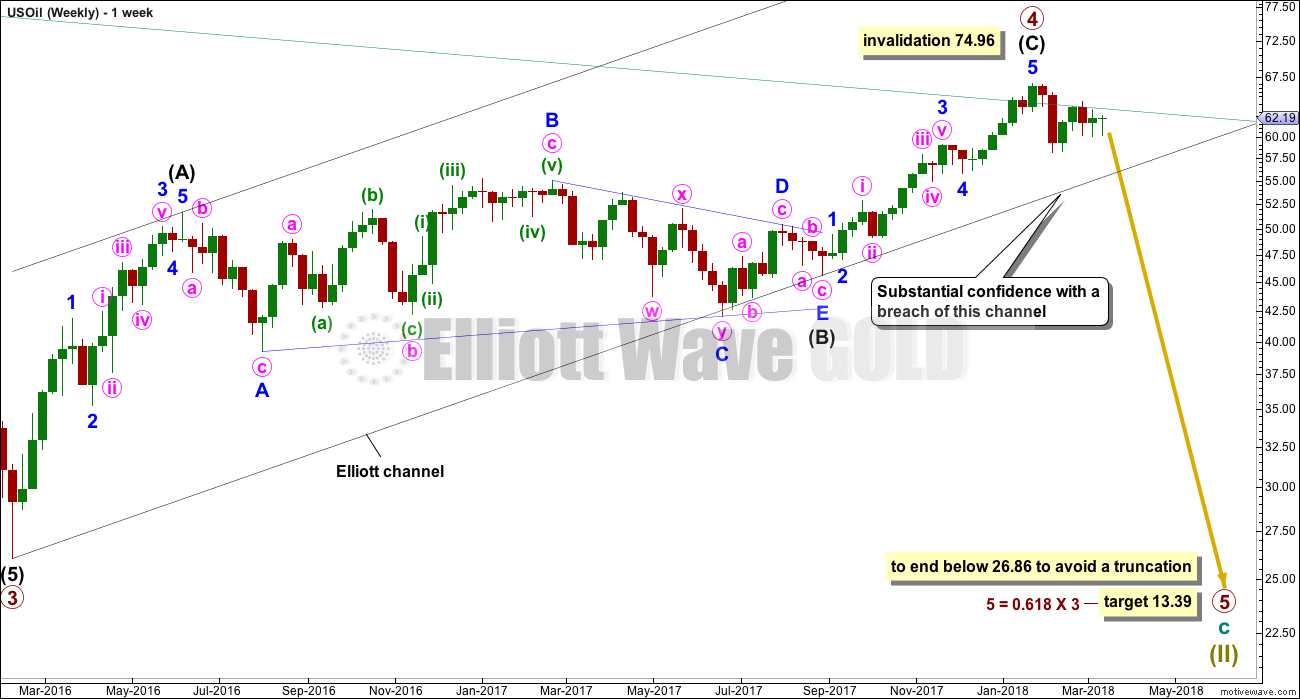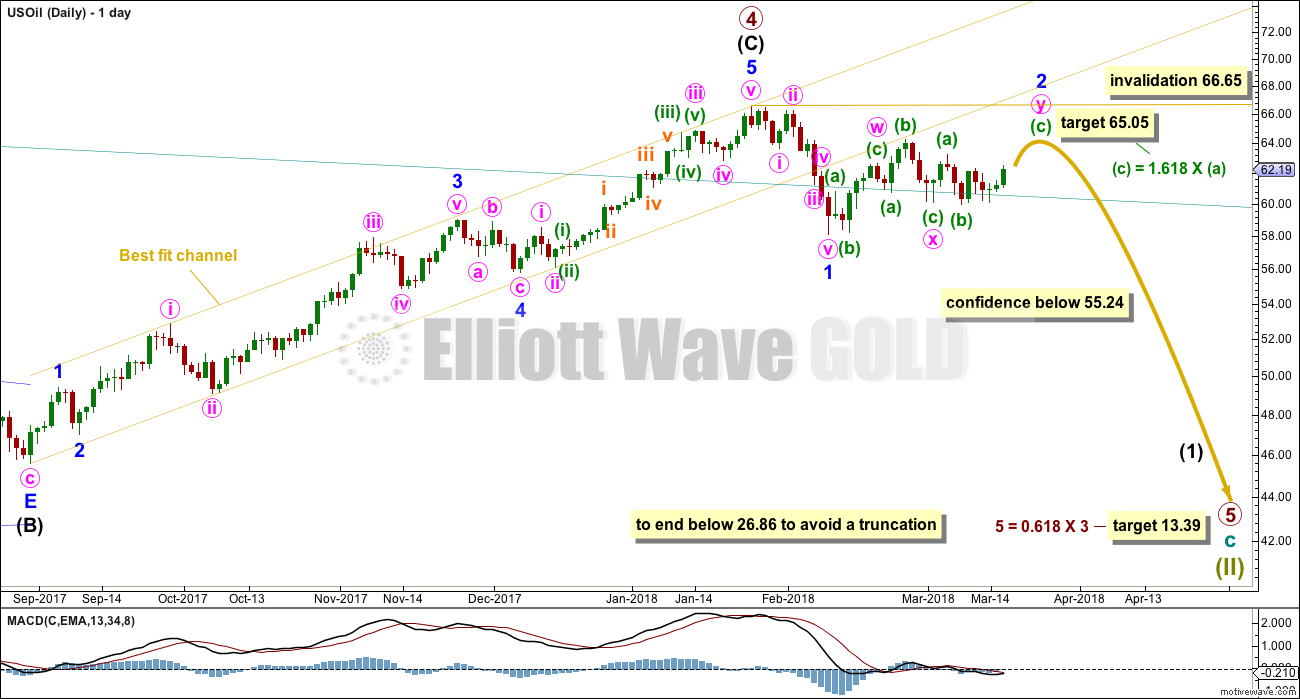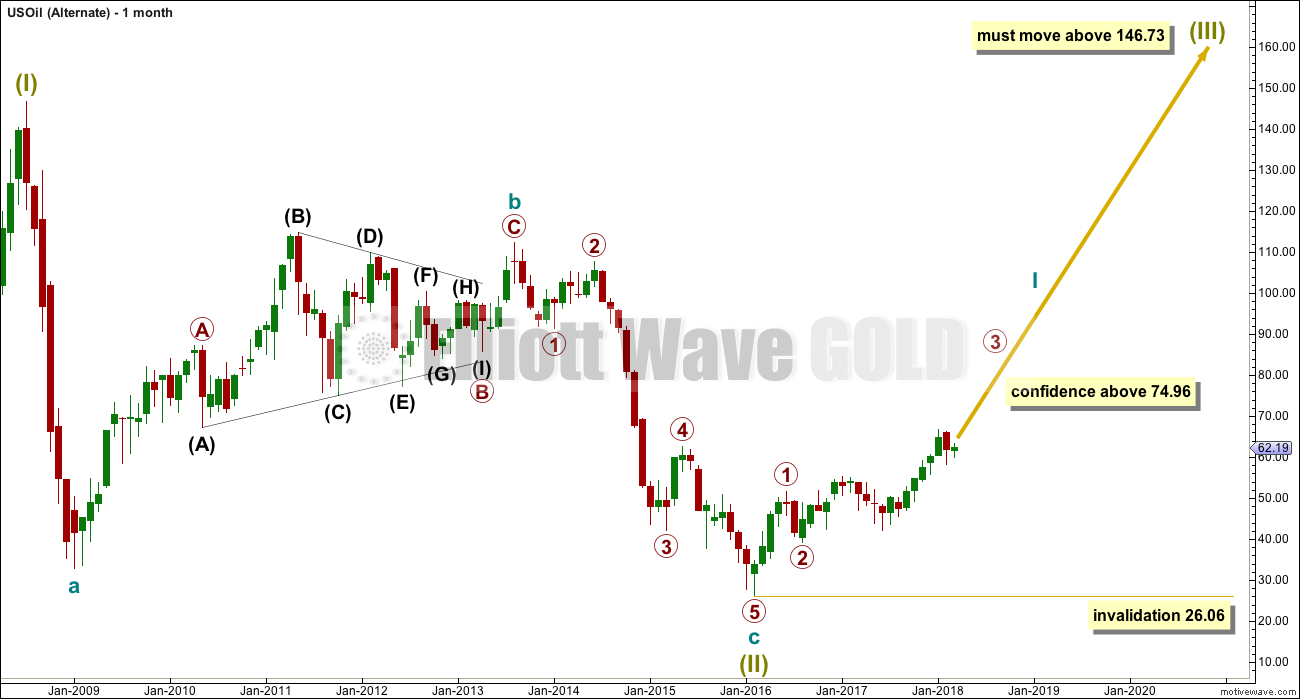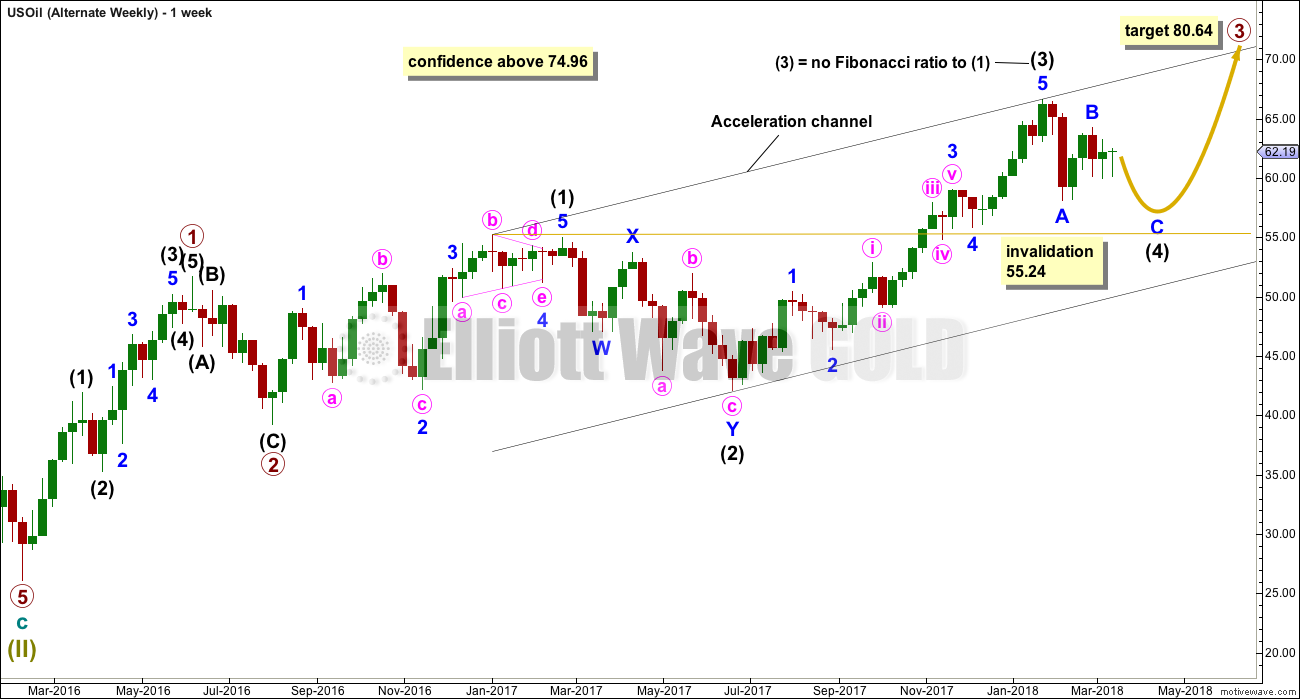Lara’s Weekly is an end of week Elliott Wave and Technical Analysis of the S&P 500, GOLD, and USOIL that focuses on the mid-to-long-term picture. This analysis service is designed for investors and swing traders.
Lara’s Weekly is at this time available to the general public, but in the near future it will be available by subscription only. I will be offering a once only awesome Grandfather rate to the earliest subscribers when Lara’s Weekly is launched as a paid subscription service. To make sure you don’t miss out and not get the Grandfather rate, be notified: click on the Notify Me button below:

S&P 500
A slight new low and then a bounce was expected for Friday. The session did not begin with a slight new low, but price did bounce.
Summary: In the short term, expect a bounce to continue to about 2,789; it may be choppy and overlapping and may last another one to few days. Thereafter, another wave down may develop.
Always practice good risk management. Always trade with stops and invest only 1-5% of equity on any one trade.
The biggest picture, Grand Super Cycle analysis, is here.
Last historic analysis with monthly charts is here. Video is here.
An alternate idea at the monthly chart level is given here at the end of this analysis.
An historic example of a cycle degree fifth wave is given at the end of the analysis here.
MAIN ELLIOTT WAVE COUNT
WEEKLY CHART
Cycle wave V must complete as a five structure, which should look clear at the weekly chart level. It may only be an impulse or ending diagonal. At this stage, it is clear it is an impulse.
Within cycle wave V, the third waves at all degrees may only subdivide as impulses.
Intermediate wave (4) has breached an Elliott channel drawn using Elliott’s first technique. The channel is redrawn using Elliott’s second technique as if intermediate wave (4) was over at the last low. If intermediate wave (4) continues sideways, then the channel may be redrawn when it is over. The upper edge may provide resistance for intermediate wave (5).
Intermediate wave (4) may not move into intermediate wave (1) price territory below 2,193.81. At this stage, it now looks like intermediate wave (4) may be continuing further sideways as a combination, triangle or flat. These three ideas are separated into separate daily charts. All three ideas would see intermediate wave (4) exhibit alternation in structure with the double zigzag of intermediate wave (2).
A double zigzag would also be possible for intermediate wave (4), but because intermediate wave (2) was a double zigzag this is the least likely structure for intermediate wave (4) to be. Alternation should be expected until price proves otherwise.
DAILY CHART – TRIANGLE
This first daily chart outlines how intermediate wave (4) may now continue further sideways as a contracting or barrier triangle. It is possible that minor wave B within the triangle was over at the last high, which would mean the triangle would be a regular triangle. Minor wave C downwards may now be underway and may be a single or double zigzag. One of the five sub-waves of a triangle is usually a more complicated multiple, and the most common sub-wave to do this is wave C.
Minor wave C may not make a new low below the end of minor wave A at 2,532.69.
Intermediate wave 2 lasted 11 weeks. If intermediate wave (4) is incomplete, then it would have so far lasted only six weeks. Triangles tend to be very time consuming structures, so intermediate wave (4) may total a Fibonacci 13 or even 21 weeks at its conclusion.
Because this is the only daily chart which expects price to continue to find support at the 200 day moving average, it is presented first; it may have a slightly higher probability than the next two daily charts.
DAILY CHART – COMBINATION
Double combinations are very common structures. The first structure in a possible double combination for intermediate wave (4) would be a complete zigzag labelled minor wave W. The double should be joined by a three in the opposite direction labelled minor wave X, which may be a complete zigzag. X waves within combinations are typically very deep; if minor wave X is over at the last high, then it would be a 0.79 length of minor wave W, which is fairly deep giving it a normal look. There is no minimum nor maximum requirement for X waves within combinations.
The second structure in the double would most likely be a flat correction labelled minor wave Y. It may also be a triangle, but in my experience this is very rare.
A flat correction would subdivide 3-3-5. Minute wave a must be a three wave structure, most likely a zigzag.
The purpose of combinations is to take up time and move price sideways. To achieve this purpose the second structure in the double usually ends close to the same level as the first. Minor wave Y would be expected to end about the same level as minor wave W at 2,532.69. This would require a strong overshoot or breach of the 200 day moving average, which looks unlikely.
HOURLY CHART
The downwards best fit channel is clearly breached by upwards movement at the start of Friday’s session, indicating the last wave down should be complete and a new wave up should be underway.
The last wave down can fit as a five on the hourly and five minute charts. This may be minute wave a of a zigzag.
If minute wave a is correctly analysed as a five, then minute wave b may not move beyond its start above 2,801.90.
Minute wave b may be any corrective structure. It may be expected to last another one to few days. So far the corrective structure has almost reached the 0.382 Fibonacci ratio of minute wave a, already, so it may continue higher now to end closer to the 0.618 Fibonacci ratio at about 2,779.
DAILY CHART – FLAT
Flat corrections are very common. The most common type of flat is an expanded flat. This would see minor wave B move above the start of minor wave A at 2,872.87.
Within a flat correction, minor wave B must retrace a minimum 0.9 length of minor wave A at 2,838.85. The most common length for minor wave B within a flat correction would be 1 to 1.38 times the length of minor wave A at 2,872.87 to 3,002.15. An expanded flat would see minor wave B 1.05 times the length of minor wave A or longer, at 2,889.89 or above.
When minor wave B is a complete corrective structure ending at or above the minimum requirement, then minor wave C downwards would be expected to make a new low below the end of minor wave A at 2,532.69 to avoid a truncation.
This wave count would require a very substantial breach of the 200 day moving average for the end of intermediate wave (4). This looks unlikely.
HOURLY CHART – FLAT
It is also possible that upwards movement is not over and minute wave c is incomplete. At this stage, minuette wave (iv) now looks grossly disproportionate to minuette wave (ii), so this wave count no longer has the right look.
If intermediate wave (4) is unfolding as a flat correction, then within it minor wave B has not yet met the minimum requirement of 0.9 the length of minor wave A at 2,838.85.
Within minute wave c, the correction of minuette wave (iv) may not move into minuette wave (i) price territory below 2,732.08.
Minuette wave (iv) has breached a channel drawn using Elliott’s first technique, so the channel is redrawn using the second technique. Draw the first trend line from the ends of minuette waves (ii) to (iv), then place a parallel copy on the end of minuette wave (iii). Minuette wave (v) may end either mid way within this channel, or about the upper edge. Friday’s upwards movement is finding support about the lower edge of this channel.
A target for minute wave c to end is calculated at minuette degree. This would see the minimum requirement for minor wave B just met.
DAILY CHART – ALTERNATE
It is possible still that intermediate wave (4) was complete as a relatively brief and shallow single zigzag.
A new all time high with support from volume and any one of a bullish signal from On Balance Volume or the AD line would see this alternate wave count become the main wave count.
Within minor wave 3, minute wave ii may not move beyond the start of minute wave i below 2,647.32.
This first alternate expects minor wave 1 was an impulse. This is the most common structure for a first wave, so this is the more likely of two alternates presented today.
DAILY CHART – SECOND ALTERNATE
It is also possible that minor wave 1 is an incomplete leading contracting diagonal. This is a less common structure for a first wave, so this is the least likely wave count published today.
The diagonal would be contracting because minute wave iii is shorter than minute wave i. Within a contracting diagonal, minute wave iv must be shorter than minute wave ii. Therefore, minute wave iv may not be equal or longer in length than minute wave ii, so it may not reach 2,660.07 or below.
Leading diagonals most often end with a small overshoot of the 1-3 trend line. As soon as price makes a small overshoot here of the upper pink i-iii trend line, if it quickly reverses and moves strongly lower, then this wave count would be indicated as more likely.
Leading diagonals in first wave positions are very commonly followed by very deep second wave corrections. If what looks like a diagonal upwards completes and price quickly reverses, then a Fibonacci retracement would be drawn along the length of the diagonal. Minor wave 2 would be expected to be deeper than the 0.618 Fibonacci ratio of minor wave 1.
Minor wave 2 may not move beyond the start of minor wave 1 below 2,532.69. Minor wave 2 may find support about the 200 day moving average.
TECHNICAL ANALYSIS
WEEKLY CHART

Click chart to enlarge. Chart courtesy of StockCharts.com.
This week moved price higher with a higher high and a higher low, but the candlestick is red and the balance of volume is down. At this time frame, it looks like there may be more support for downwards movement than upwards within the week, but it would be better to look inside the week at daily volume bars to draw a conclusion.
The pullback has brought ADX down from very extreme and RSI down from extremely overbought. There is again room for a new trend to develop.
DAILY CHART
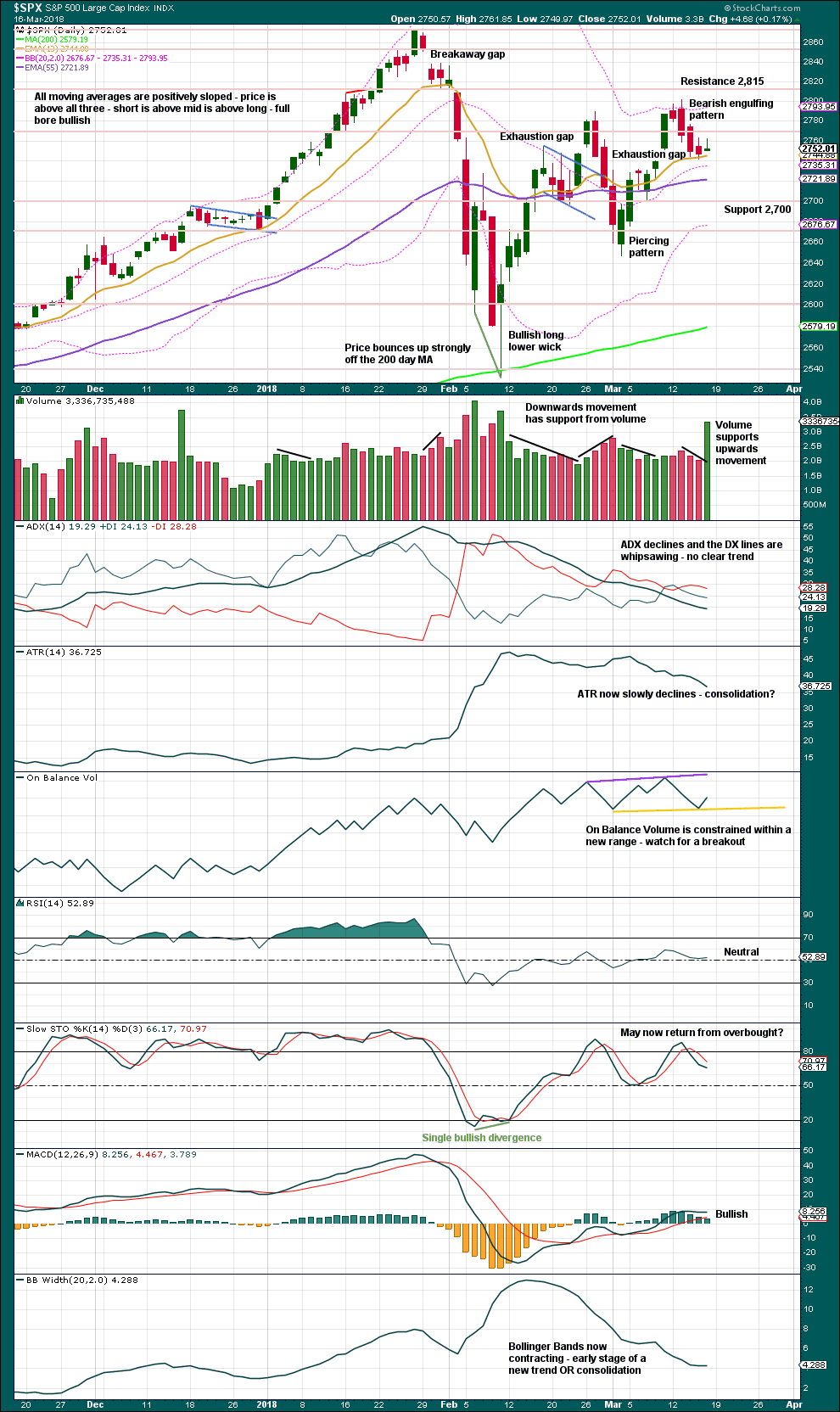
Click chart to enlarge. Chart courtesy of StockCharts.com.
While the small amount of upwards movement on Friday does have support from volume, this was an options expiry date and so a volume spike would be expected. Short term volume is bullish still, but the longer upper wick on Friday’s Gravestone doji is bearish. This doji should not be read as a reversal signal though as it does not come at the end of an upwards trend.
The support line for On Balance Volume is redrawn.
VOLATILITY – INVERTED VIX CHART
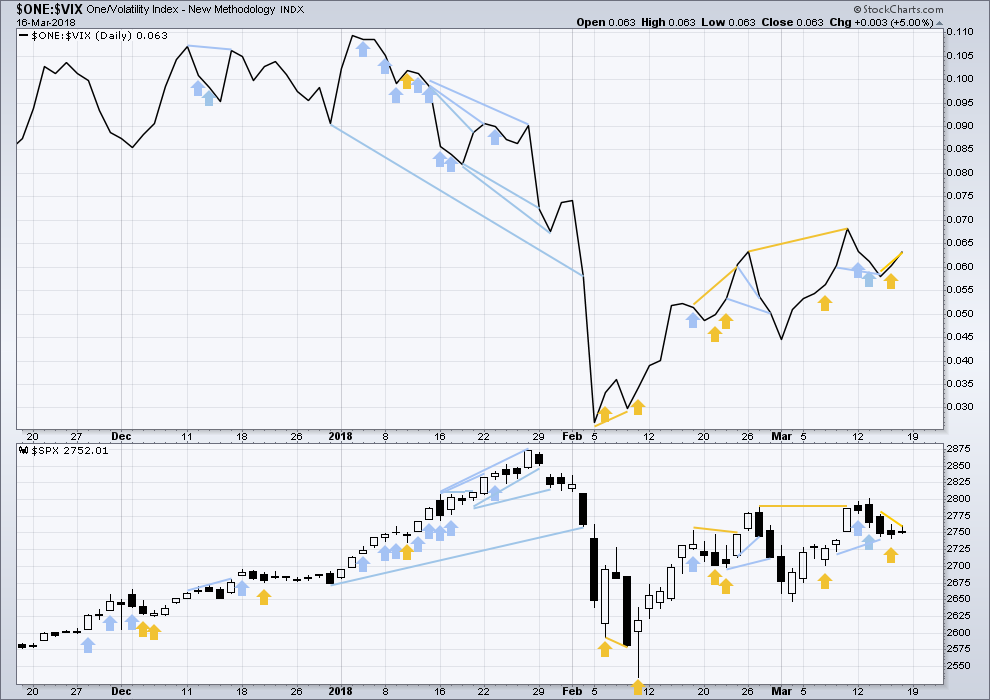
Click chart to enlarge. Chart courtesy of StockCharts.com.
So that colour blind members are included, bearish signals will be noted with blue and bullish signals with yellow.
Normally, volatility should decline as price moves higher and increase as price moves lower. This means that normally inverted VIX should move in the same direction as price.
Bullish divergence in last analysis has been followed by an upwards day. This may now be resolved, or it may need another upwards day to resolve it.
Inverted VIX on Friday made a new high above the prior high three sessions ago, but price has not. This divergence is bullish.
BREADTH – AD LINE
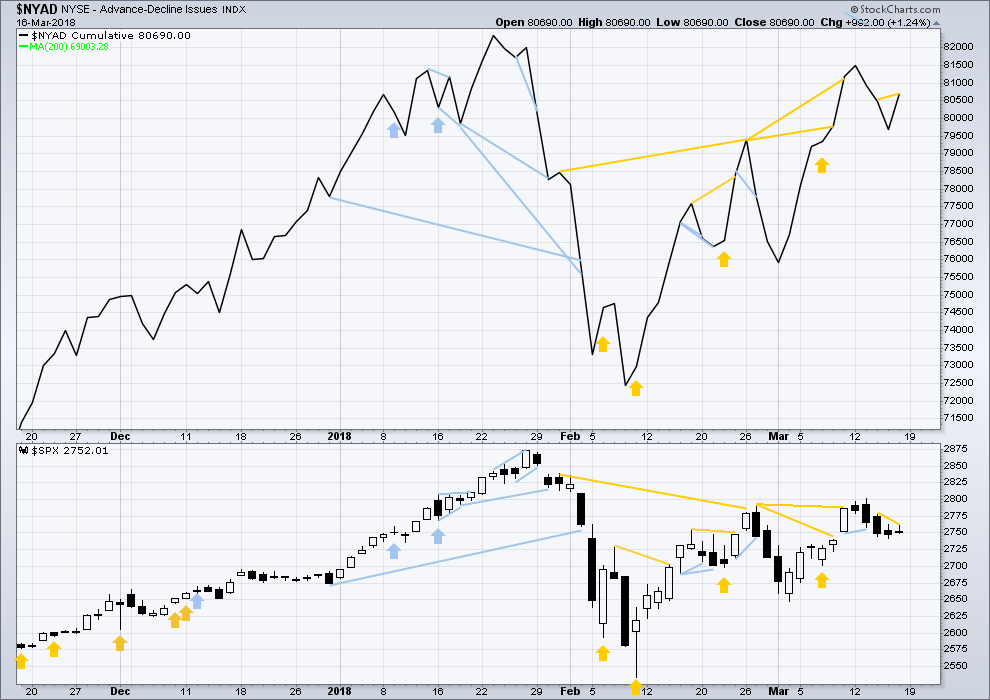
Click chart to enlarge. Chart courtesy of StockCharts.com.
There is normally 4-6 months divergence between price and market breadth prior to a full fledged bear market. This has been so for all major bear markets within the last 90 odd years. With no longer term divergence yet at this point, any decline in price should be expected to be a pullback within an ongoing bull market and not necessarily the start of a bear market.
All of small, mid and large caps last week completed an outside week. All sectors of the market at this time appear to be in a consolidation.
Breadth should be read as a leading indicator.
The AD line on Friday has made a new high above the prior high three sessions ago, but price has not. This divergence is bullish.
DOW THEORY
All indices have made new all time highs as recently as eight weeks ago, confirming the ongoing bull market.
The following lows need to be exceeded for Dow Theory to confirm the end of the bull market and a change to a bear market:
DJIA: 17,883.56.
DJT: 7,039.41.
S&P500: 2,083.79.
Nasdaq: 5,034.41.
Charts showing each prior major swing low used for Dow Theory are here.
GOLD
Another test of support about 1,310 to 1,305 was expected. This is what has happened.
Summary: Expect the upwards swing to resume, which may be choppy and overlapping. The target at 1,391 may be too high; upwards movement may find strong resistance about 1,365 – 1,375.
However, a bearish signal from On Balance Volume at the daily chart level today puts some doubt on this view. If price can close below support at 1,305, then a downwards breakout may be underway.
New updates to this analysis are in bold.
Grand SuperCycle analysis is here.
Last in-depth historic analysis with monthly and several weekly charts is here, video is here.
There are multiple wave counts at this time at the weekly and monthly chart levels. In order to make this analysis manageable and accessible only two will be published on a daily basis, one bullish and one bearish. This does not mean the other possibilities may not be correct, only that publication of them all each day is too much to digest. At this stage, they do not diverge from the two possibilities below.
BULLISH ELLIOTT WAVE COUNT
FIRST WEEKLY CHART
Cycle wave b may be a single zigzag. Zigzags subdivide 5-3-5. Primary wave C must subdivide as a five wave structure and may be either an impulse or an ending diagonal. Overlapping at this stage indicates an ending diagonal.
Within an ending diagonal, all sub-waves must subdivide as zigzags. Intermediate wave (4) must overlap into intermediate wave (1) price territory. This diagonal is expanding: intermediate wave (3) is longer than intermediate wave (1) and intermediate wave (4) is longer than intermediate wave (2). Intermediate wave (5) must be longer than intermediate wave (3), so it must end above 1,398.41 where it would reach equality in length with intermediate wave (3).
Within the final zigzag of intermediate wave (5), minor wave B may not move beyond the start of minor wave A below 1,236.54.
Within the diagonal of primary wave C, each sub-wave is extending in price and so may also do so in time. Within each zigzag, minor wave B may exhibit alternation in structure and may show an increased duration.
Within intermediate wave (1), minor wave B was a triangle lasting 11 days. Within intermediate wave (2), minor wave B was a zigzag lasting 2 days. Within intermediate wave (3), minor wave B was a regular flat lasting 60 days. Within intermediate wave (4), minor wave B was a regular contracting triangle lasting 40 days. Within intermediate wave (5), minor wave B may be expected to be an expanded flat, combination or running triangle to exhibit some alternation in structure. It may last as long as 40 to 60 days. So far it has lasted 29 days and the structure is incomplete.
This first weekly chart sees the upwards wave labelled primary wave A as a five wave structure. It must be acknowledged that this upwards wave looks better as a three than it does as a five. The fifth weekly chart below will consider the possibility that it was a three.
FIRST DAILY CHART
Within the ending diagonal, intermediate wave (5) must sub-divide as a zigzag.
Minor wave B may now be either a flat or a combination. An alternate idea of a triangle for minor wave B is published today in a separate chart below.
Within either a flat or combination for minor wave B, the correction of minute wave b or x may be unfolding as an expanded flat correction. When this expanded flat is complete, then a downwards swing for minute wave c or y would be expected.
Because both options of a flat or combination for minor wave B now expect minute wave b or x to be completing as an expanded flat, they both need to see a five up complete for minuette wave (c). Within the five up, subminuette wave i would be complete at the last small swing high. Subminuette wave ii may have ended at Friday’s low.
If minor wave B is unfolding as a flat correction, then minute wave c may move reasonably below the low of minute wave a at 1,307.09 and must be a five wave structure.
If minor wave B is unfolding as a combination, then minute wave y may be a flat or triangle and may end about the same level as minute wave w at 1,307.09.
HOURLY CHART
Subminuette wave ii may now be over.
Micro wave C may have bought price back down to test support, which is strong about 1,310 – 1,305. Micro wave C is now a complete five wave structure. Subminuette wave iii may have begun at the end of Friday’s session. There is a strong Bullish Piercing pattern at the low.
If it continues further, then subminuette wave ii may not move beyond the start of subminuette wave i below 1,303.08.
FIRST DAILY CHART – ALTERNATE
This alternate daily chart is identical to the first daily chart up to the high labelled minor wave A. Thereafter, it looks at a different structure for minor wave B.
Minor wave B may be an incomplete triangle, and within it minute wave a may have been a double zigzag. All remaining triangle sub-waves must be simple A-B-C structures, and three of the four remaining sub-waves must be simple zigzags. One remaining sub-wave may be a flat correction.
Minute wave b may be unfolding upwards as a single zigzag, and within it minuette wave (b) may not move beyond the start of minuette wave (a) below 1,303.08.
This alternate wave count expects weeks of choppy overlapping movement in an ever decreasing range.
BEARISH ELLIOTT WAVE COUNT
FIFTH WEEKLY CHART
There were five weekly charts published in the last historic analysis. This fifth weekly chart is the most immediately bearish wave count, so this is published as a bearish possibility.
This fifth weekly chart sees cycle wave b as a flat correction, and within it intermediate wave (B) may be a complete triple zigzag. This would indicate a regular flat as intermediate wave (B) is less than 1.05 the length of intermediate wave (A).
If cycle wave b is a flat correction, then within it primary wave B must retrace a minimum 0.9 length of primary wave A at 1,079.13 or below. The most common length of B waves within flats is from 1 to 1.38 times the length of the A wave. The target calculated would see primary wave B end within this range.
I have only seen two triple zigzags before during my 10 years of daily Elliott wave analysis. If this wave count turns out to be correct, this would be the third. The rarity of this structure is identified on the chart.
TECHNICAL ANALYSIS
WEEKLY CHART

Click chart to enlarge. Chart courtesy of StockCharts.com.
Price is again at support and On Balance Volume is almost at support. With volume continuing to decline, it looks reasonable to expect a turn back to an upwards swing about here.
Price is still range bound.
DAILY CHART
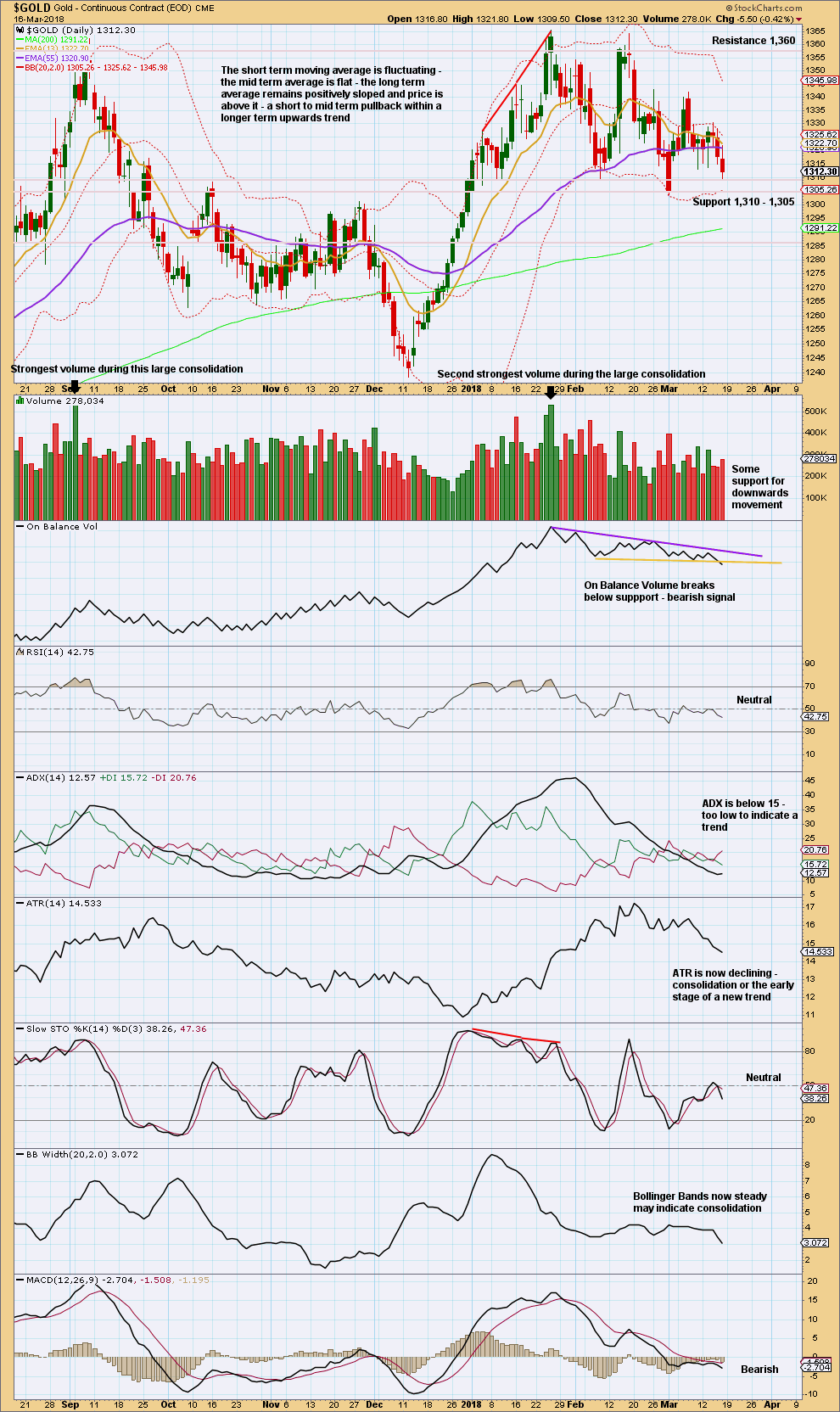
Click chart to enlarge. Chart courtesy of StockCharts.com.
Looking at the bigger picture, Gold has been within a large consolidation since about January 2017 (this chart does not show all of this large consolidation), and during this consolidation it is two upwards days that have strongest volume and an upwards week that has strongest volume. Volume suggests an upwards breakout may be more likely than downwards.
Currently, Gold is within a smaller consolidation that began in early January 2018. This consolidation is delineated by support about 1,310 to 1,305 and resistance (final) about 1,375. It is an upwards day during this smaller consolidation that has strongest volume, suggesting an upwards breakout may be more likely here than downwards.
With a little support for downwards movement on Friday and a bearish signal from On Balance Volume, price may be ready to break out of this smaller consolidation downwards. This does not support the Elliott wave count.
Price needs to close below 1,305, preferably on a strong downwards day, for confidence in a downwards breakout. If there is support from volume, then more confidence may be had (but it is not necessary for a downwards breakout).
GDX WEEKLY CHART
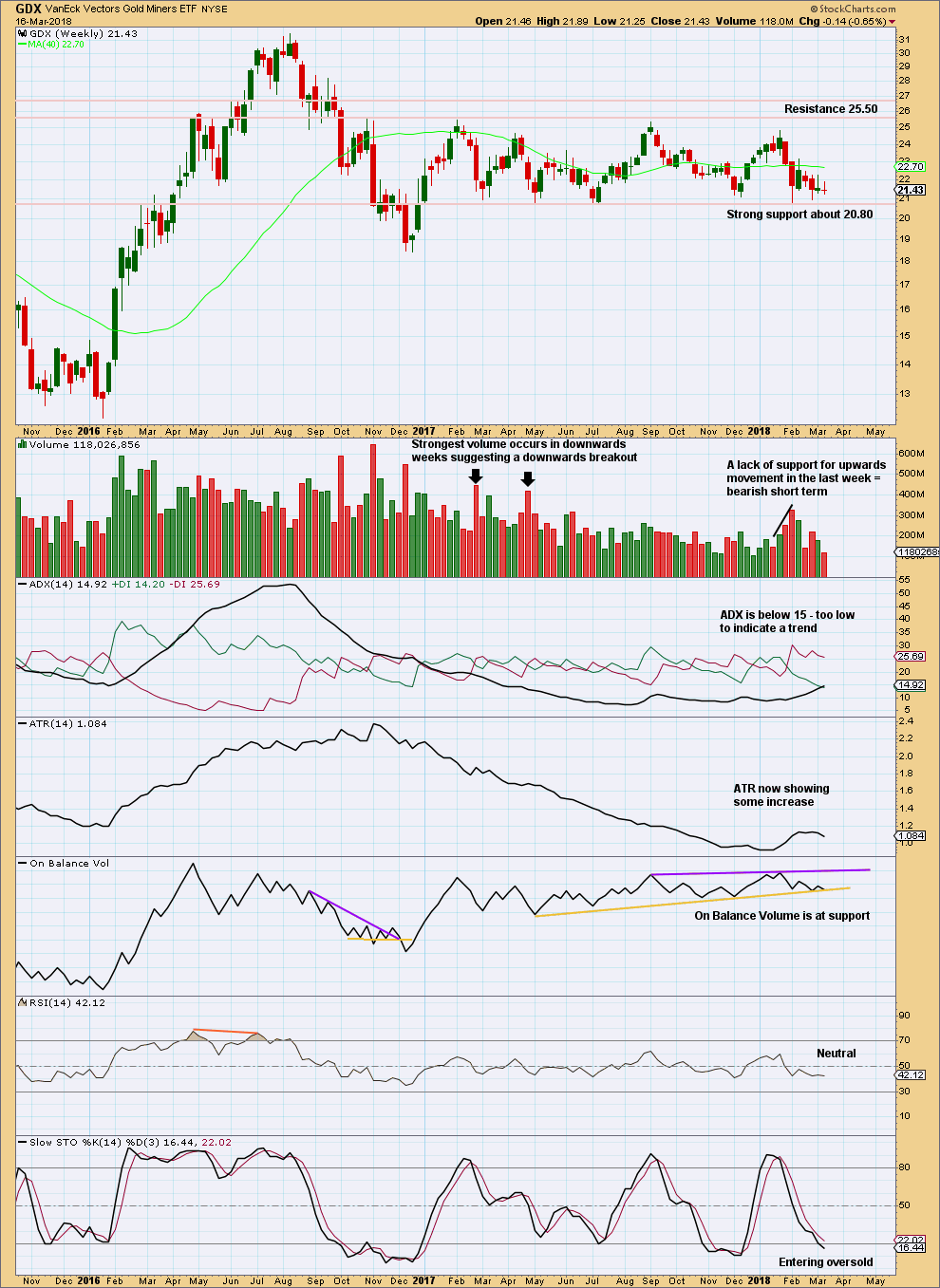
Click chart to enlarge. Chart courtesy of StockCharts.com.
Support about 20.80 has been tested about eight times and so far has held. The more often a support area is tested and holds, the more technical significance it has.
In the first instance, expect this area to continue to provide support. Only a strong downwards day, closing below support and preferably with some increase in volume, would constitute a downwards breakout from the consolidation that GDX has been in for a year now.
Resistance is about 25.50. Only a strong upwards day, closing above resistance and with support from volume, would constitute an upwards breakout.
With On Balance Volume again at support and price close to support, it is reasonable to expect a turn and an upwards swing about here. There is a little room though for a little more downwards movement.
GDX DAILY CHART
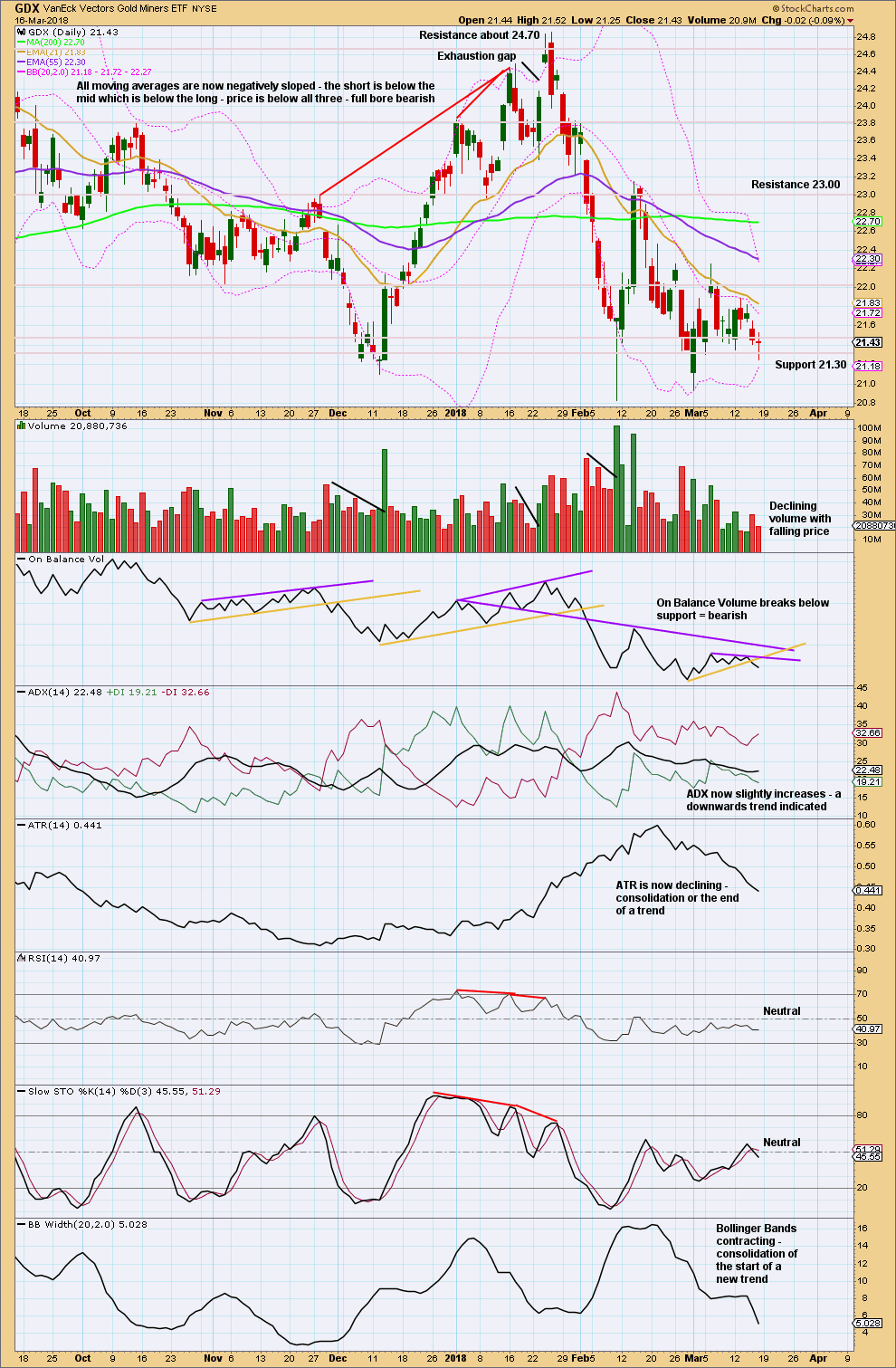
Click chart to enlarge. Chart courtesy of StockCharts.com.
The doji for Friday, coming within a consolidation, cannot be read as a reversal signal. It looks like price may be again finding support close to 21.30.
The signal from On Balance Volume is weak because the line has a reasonable slope and is not very long held. It was tested four times though, so this is identified as a weak bearish signal. The signal makes no comment though on how far nor for how long downwards movement may result.
While ADX now indicates a downwards trend, for confidence in this a breakout below support with a close below 21.30 would be necessary. If this happens with support from volume, then more confidence in a downwards trend may be had.
US OIL
Another small range week, this time an inside week, does not change the Elliott wave analysis.
Summary: The outlook will remain bearish while price remains below 66.65. A new high above 66.65 at this stage would be very bullish.
In the short term, still look for a small bounce to end a little above 63.28 with a possible target at 65.05, then the continuation of a downwards trend.
Always practice good risk management as the most important aspect of trading. Always trade with stops and invest only 1-5% of equity on any one trade. Failure to manage risk is the most common mistake new traders make.
New updates to this analysis are in bold.
MAIN WAVE COUNT
MONTHLY CHART
Within the bear market, cycle wave b is seen as ending in May 2011. Thereafter, a five wave structure downwards for cycle wave c begins.
Primary wave 1 is a short impulse lasting five months. Primary wave 2 is a very deep 0.94 zigzag lasting 22 months. Primary wave 3 is a complete impulse with no Fibonacci ratio to primary wave 1. It lasted 30 months.
There is alternation in depth with primary wave 2 very deep and primary wave 4 relatively shallow. There is inadequate alternation in structure, both are zigzags. So far primary wave 4 has lasted 23 months. At this stage, there is almost perfect proportion between primary waves 2 and 4.
Primary wave 4 may not move into primary wave 1 price territory above 74.96.
The wider Elliott channel (teal) about this whole movement may offer support to primary wave 5.
WEEKLY CHART
Primary wave 4 subdivides as a zigzag, and within it intermediate wave (C) may now be complete. If primary wave 5 were to only reach equality in length with primary wave 3, it would end with a small truncation. A target for primary wave 5 may best be calculated at intermediate degree. That can only be done when intermediate waves (1) through to (4) within primary wave 5 are complete.
For now a target will be calculated at primary degree using a ratio between primary waves 3 and 5. This target only has a small probability. This target will be recalculated as primary wave 5 nears its end, so it may change.
An Elliott channel is added to this possible zigzag for primary wave 4. A breach of the lower edge of this channel would provide a very strong indication that primary wave 4 should be over and primary wave 5 should be underway. Look out for some support on the way down, perhaps a short term bounce about the lower edge of the channel.
DAILY CHART
Minor wave 1 will subdivide as a complete impulse at lower time frames.
Minor wave 2 may still be an incomplete double combination. The first structure in the double may be a complete zigzag labelled minute wave w. The double may be joined by a three in the opposite direction, an expanded flat labelled minute wave x. The second structure in the double may be an incomplete expanded flat labelled minute wave y. At 65.05 minuette wave (c) would reach 1.618 the length of minuette wave (a).
When minor wave 2 is finally complete, then minor wave 3 downwards may begin. When minor wave 2 is complete and the start of minor wave 3 is known, then a target for minor wave 3 to end may be calculated. That cannot be done yet.
Minor wave 2 may not move beyond the start of minor wave 1 above 66.65.
A new low below 55.24 would invalidate the bullish alternate below and provide reasonable confidence in this main wave count.
ALTERNATE WAVE COUNT
MONTHLY CHART
It is possible that the bear market for Oil is over and a new bull market is in the very early stages.
A huge zigzag down to the last low may be complete and is labelled here Super Cycle wave (II).
Cycle wave b must be seen as complete in August 2013 for this wave count to work. It cannot be seen as complete at the prior major swing high in May 2011.
Cycle wave b is seen as a zigzag, and within it primary wave B is seen as a running contracting triangle. These are fairly common structures, although nine wave triangles are uncommon. All subdivisions fit.
Primary wave C moves beyond the end of primary wave A, so it avoids a truncation. But it does not have to move above the price territory of primary wave B to avoid a truncation, which is an important distinction.
If cycle wave b begins there, then cycle wave c may be seen as a complete five wave impulse.
Super Cycle wave (III) must move beyond the end of Super Cycle wave (I). It must move far enough above that point to allow room for a subsequent Super Cycle wave (IV) to unfold and remain above Super Cycle wave (I) price territory.
WEEKLY CHART
If a new bull market is in the very early stages for Oil, then it may have begun with two overlapping first and second waves at primary then at intermediate degree.
Primary wave 3 may only subdivide as an impulse, and within it intermediate wave (3) may be complete.
Intermediate wave (4) may not move into intermediate wave (1) price territory below 55.24. Intermediate wave (4) would most likely be incomplete. It may continue further sideways or lower.
TECHNICAL ANALYSIS
MONTHLY CHART

Click chart to enlarge. Chart courtesy of StockCharts.com.
The strongest recent monthly volume is for the downwards month of August 2017. This is bearish.
The rise in price had support from volume for the month of January. Downwards movement did not have support from rising volume for the now completed month of February. This is bullish. MACD and On Balance Volume are also both bullish. Overall, this chart is more bullish than bearish.
RSI indicates there is room for upwards movement to continue.
DAILY CHART
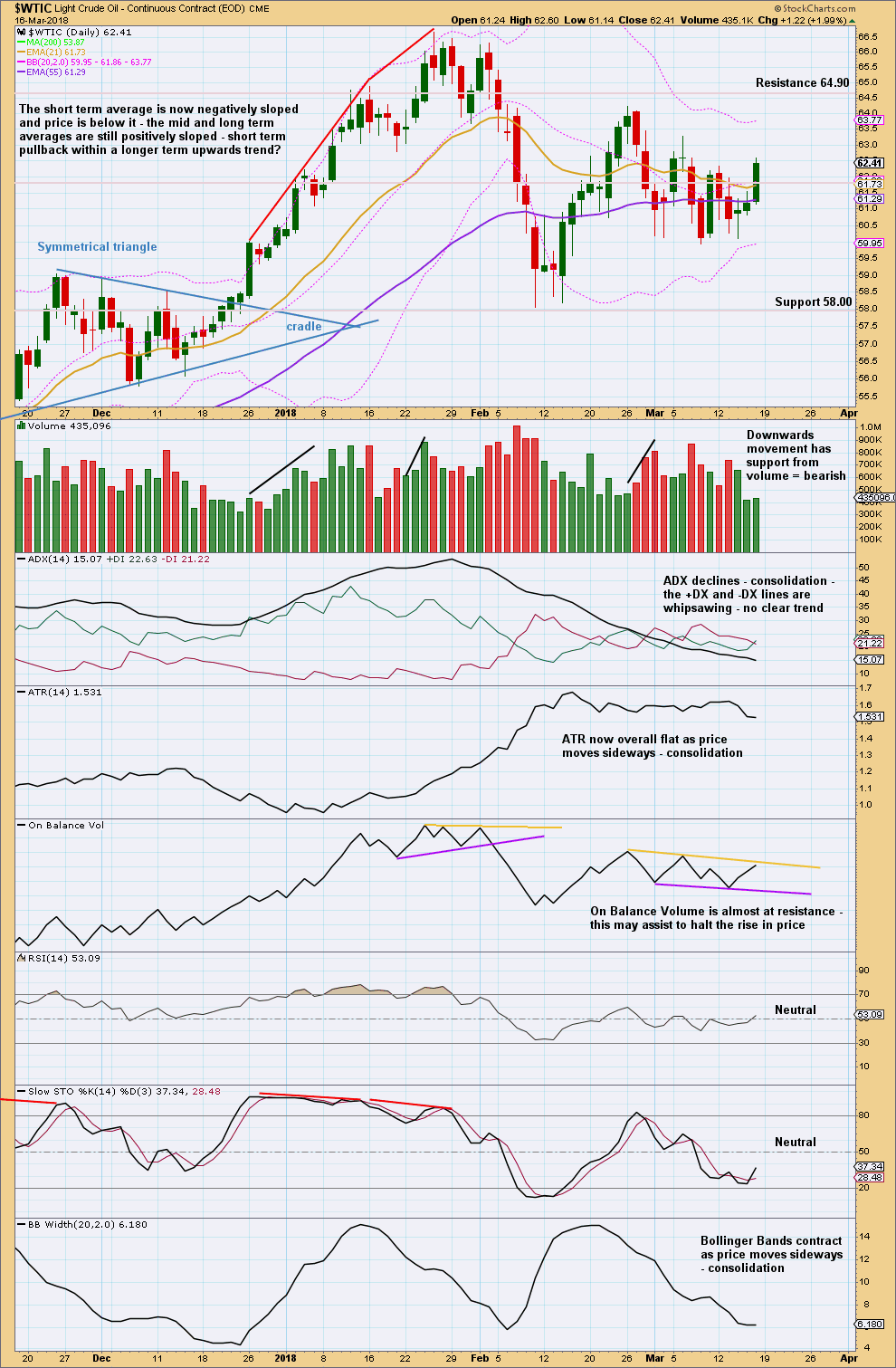
Click chart to enlarge. Chart courtesy of StockCharts.com.
The pattern of stronger volume for downwards days and weaker volume for upwards days continues. The short term volume profile supports the first Elliott wave count.
There is a very small amount of room for On Balance Volume to move higher. Resistance by On Balance Volume may serve to halt the rise in price.
VOLATILITY INDEX

Click chart to enlarge. Chart courtesy of StockCharts.com.
Price has made a new high above the prior high three sessions ago, but volatility has not made a corresponding new low. This indicates weakness within price and is interpreted as bearish.

